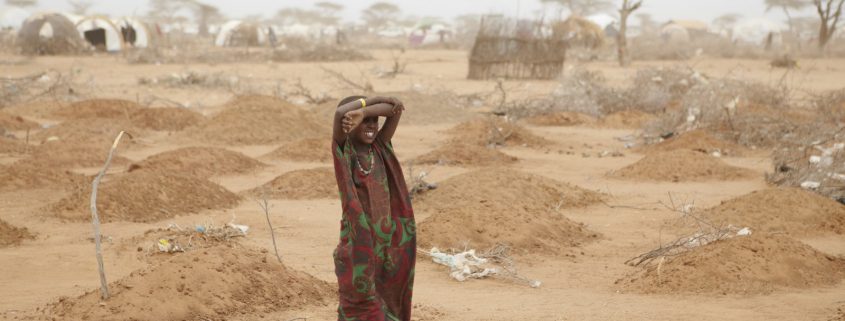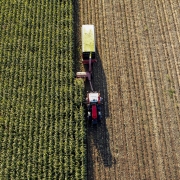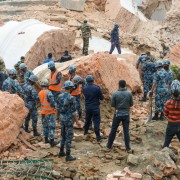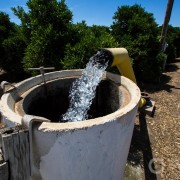Drought, Heat, and Conflict Strand Residents of Dadaab
World’s largest refugee camp illustrates human costs of water-scarce era.
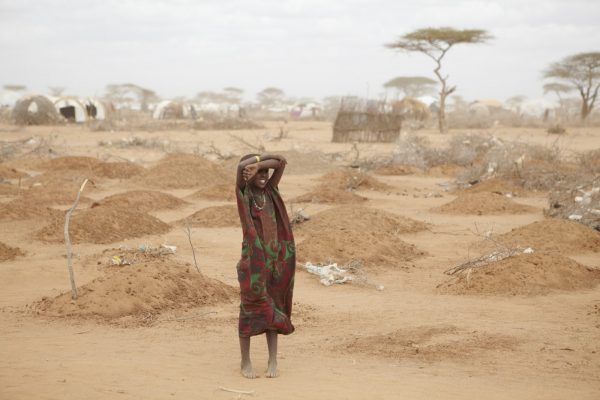
A mass grave for children in Dadaab during the 2011 East Africa drought. Photo courtesy of Wikimedia
By Kayla Cragg, Circle of Blue
The desert of thorns and rocks northwest of Nairobi, Kenya is so unforgiving that it takes all day and a good bit of the night to reach the Dadaab refugee camp about 300 miles away near the border with Somalia. Established in 1992 to care for Muslim families fleeing the Somalia civil war, the mammoth camp, the largest refugee installation in the world, shelters 250,000 people snared in a treacherous tangle of drought, crop failures, terrorism, and human conflict.
Last year, following assertions that Dadaab could be home base for members of the Somali-based Al-Shabaab terrorist organization, the Kenyan government tried to close the camp. In February, a Kenyan high court declared the government’s closure order was unconstitutional because it directly targeted the Somali refugees who form the overwhelming share of the camp’s inhabitants. The court said the closure order was an unconstitutional act of group persecution.
The court’s intervention in the government’s closure plan raised anew Dadaab’s international profile as a forbidding place that illuminates so many of the planet’s water-related emergencies. One of the primary sources of the crisis in Dadaab and in the East African countries that surround it is dire water scarcity. Harvests are failing and food prices are soaring throughout the region. Clean drinking water is a scarce resource. The hostile conditions are bullying millions of residents, producing some of the world’s most dangerous living conditions, and causing political conflict in and outside East Africa.
Trapped By Drought and War
The convergence of so many life threatening trends means that families housed in Dadaab are essentially trapped with nowhere to go. The 1951 UN Refugee Convention declares that refugees cannot be repatriated unless they can reasonably be guaranteed safety in their home country. For residents of Dadaab, ongoing personal danger and looming famine in Somalia mean a safe return is out of the question.
The same is true for East African refugees unable to survive in their home territories. Warring factions in South Sudan have destroyed crops, blocked supply routes, and attacked aid workers. People in Somalia are starving because of similar conditions. Food insecurity in these countries is as much a man-made catastrophe as it is meteorological.
The people of Somalia and South Sudan have nowhere to flee. Countries that once welcomed refugees in Africa and in Europe are closing their borders amid a wave of anti-refugee sentiment. Thousands of people have trudged overland to the North African shore of the Mediterranean Sea, only to die in the crossing or be turned back at European borders. The convergence of severe drought, armed conflict, and unsparing immigration policy is stranding millions of Africans in an unforgiving tragedy of deprivation and war. The United Nations declared in March that the East African drought, along with possible famine in Yemen and Nigeria, constitutes the largest humanitarian crisis since World War II.
Starvation Looms
Ethiopia, Kenya, Somalia, and South Sudan have felt the worst effects of the expanding crisis. Ethiopia braces for the worst drought in decades, with an estimated 5.6 million people requiring emergency aid. In mid-February, Kenya declared a national disaster amidst government projections that 1.3 million citizens were in need of immediate assistance. Somalia declared a national emergency, and South Sudan has acknowledged full-on famine. In the two nations, almost 8 million people could starve. The United Nations says that it needs to raise upwards of $4.5 billion by July in order to avert widespread starvation in East Africa and the Horn of Africa.
If all if this seems familiar, it is to some extent. Just six years ago the worst drought in 60 years unfolded in East Africa. Early warnings were largely ignored by the international community. As a result, 260,000 people starved to death, many before famine was officially declared.
This year, the trouble is magnified by the severity of the ecological and political conditions. The number of refugees in Africa has nearly doubled since 2011, with an estimated five million displaced people last year. A majority of these are Somalis and South Sudanese who have fled conflict and relocated in Kenya, Ethiopia, and Uganda.
Ethiopia, Kenya, and Uganda collectively host over 1.7 million refugees and respectively rank fifth, seventh, and eighth among countries hosting the largest number of refugees, according to the United Nations.
As conditions deteriorate, many refugees set their sights on immigrating to the United States or Europe. The United States’ recent travel ban thwarted those hopes. The current proposed ban bars any refugees from entering the United States for 120 days. It also bans citizens of Somalia, Sudan, and four other volatile countries for 90 days.
Some 26,000 refugees in Kenya—mostly Somali—have been affected by the ban, according to the United Nations High Commissioner on Refugees (UNHCR). Those people were vetted and soon to be resettled in the U.S. Now, as food in East Africa runs out, they wait.
The future of immigration policy in Europe looks dismal as well. Many European nations closed their doors to refugees. Countries like the Netherlands, France, and Germany, which have tended to be more inviting toward refugees, are now becoming embroiled in anti-immigration sentiment. Immigration will be a key issue in upcoming elections in these nations.
Relief in Ethiopia and Uganda, Maybe
As options disappear elsewhere, refugees stream into Ethiopia. UNHCR estimates that over one hundred refugees cross into Ethiopia per day. Over 700,000 Somali and South Sudanese citizens already reside there. Although the country remains open to those fleeing conflict and starvation, it is also becoming strained as resources diminish. Camps are overcrowded and unsanitary; those who live outside of camps are contending with local residents for jobs, food, and water.
For many refugees, a final hope may be in Uganda. Food prices in Uganda are on the rise—in Kampala, beans and cassava flour are 25 percent more expensive than they were a year ago—but otherwise the country has been less impacted by drought than its counterparts. Uganda also handles refugees in a unique way, setting aside plots of land for permanent resettlement instead of building camps. Until now, this system has worked well, but time will tell if Uganda can withstand the pressures of rising food prices and increased refugees.
Kayla Ritter is a recent graduate of Michigan State University, where she studied International Relations and Teaching English to Speakers of Other Languages. She is currently based in Manton, Michigan. Kayla enjoys running, writing, and traveling. Contact Kayla Ritter

